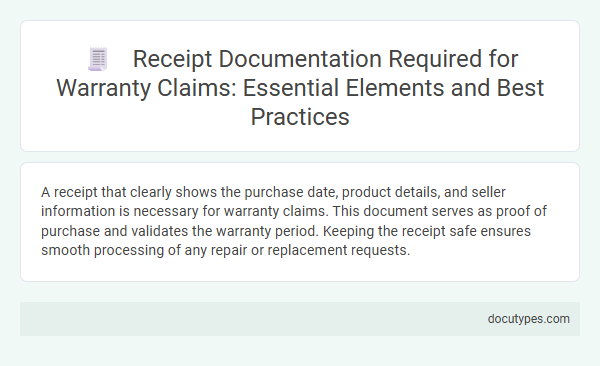A receipt that clearly shows the purchase date, product details, and seller information is necessary for warranty claims. This document serves as proof of purchase and validates the warranty period. Keeping the receipt safe ensures smooth processing of any repair or replacement requests.
Introduction to Warranty Claims and Receipt Documentation
Warranty claims require specific documentation to validate your purchase and ensure coverage. The receipt serves as the primary proof of purchase, detailing essential information such as the date, seller, and product description.
Without the proper receipt document, warranty providers may reject claims or limit support. Understanding which receipt is necessary helps streamline the claims process and protects your consumer rights.
Importance of Receipts in Warranty Processes
Receipts serve as essential proof of purchase required for warranty claims. They verify the date and place of purchase, confirming eligibility for warranty services.
Without a valid receipt, processing warranty claims can be delayed or denied. The receipt contains critical information such as product details, purchase date, and price. Keeping your receipt safe ensures smooth warranty service and protects your consumer rights.
Essential Information Required on Receipts
Receipts play a crucial role in processing warranty claims by providing proof of purchase and product details. Essential information on the receipt ensures smooth verification and eligibility for warranty services.
- Date of purchase - Confirms the purchase date to validate the warranty period.
- Product description - Includes model number or product name to identify the item.
- Seller information - Contains retailer name and contact details to confirm the origin of purchase.
Common Types of Receipt Documentation Accepted
Receipt documentation plays a crucial role in validating warranty claims for purchased products. Different types of receipts are commonly accepted to prove the date and authenticity of the transaction.
- Original Purchase Receipt - The standard proof of purchase typically includes the date, store name, product details, and price paid.
- Electronic Receipt - Digital copies sent via email or accessible through retailer websites are widely accepted for warranty verification.
- Credit Card or Bank Statement - Financial statements showing the transaction can serve as supplementary proof when the original receipt is unavailable.
Ensuring you retain a clear and accurate receipt documentation simplifies the warranty claim process and strengthens your eligibility for service or replacement.
Mandatory Elements for Valid Warranty Receipts
For warranty claims, a valid receipt document must include specific mandatory elements to ensure approval. Essential details such as the purchase date, item description, price, and seller information are required for verification purposes. You should always retain receipts that clearly display these components to facilitate a smooth warranty claim process.
Best Practices for Collecting and Storing Receipts
For warranty claims, a detailed proof of purchase receipt is essential, showing the product name, purchase date, and vendor information. Best practices include scanning or photographing receipts immediately after purchase and organizing them digitally by date or product category. You should store both physical and digital copies securely to ensure quick access when making warranty claims.
How to Submit Receipt Documentation for Warranty Claims
Which receipt document is necessary for warranty claims? A detailed original receipt showing the purchase date and product description is required. Submitting a clear copy of this receipt proves the purchase and validates warranty eligibility.
How to submit receipt documentation for warranty claims? Scan or photograph the original receipt ensuring all information is legible. Upload the image through the manufacturer's online warranty portal or include it with your mailed claim form to complete the process.
Tips for Ensuring Receipt Legibility and Authenticity
| Which Receipt Document Is Necessary for Warranty Claims? |
|---|
| A clear and legible original receipt is essential for processing warranty claims. This document must include the purchase date, item description, price, and the seller's details. Digital receipts sent via email are acceptable if they contain all necessary information and can be verified. Copies or photographs of receipts might be accepted only if the original is unavailable and authenticity can be confirmed. |
| Tips for Ensuring Receipt Legibility and Authenticity |
| Store receipts in a safe, dry place to prevent fading or damage. Use a scanner or a high-resolution camera to create digital backups, preserving essential details such as date, item name, and store information. Avoid writing on or altering the receipt to maintain authenticity. When receiving electronic receipts, save the email in a dedicated folder and consider printing a hard copy for easy access. Regularly check that digital copies are readable and that all information remains visible for warranty claims. |
Frequently Encountered Issues with Receipt Documentation
Receipt documents are essential for validating warranty claims, as they provide proof of purchase and date of transaction. Retailers and manufacturers often require original receipts to process warranty requests effectively.
Common issues with receipt documentation include faded print, missing transaction details, and lost receipts. These problems can lead to delays or denial of warranty claims, complicating customer support and repair processes.
Which Receipt Document Is Necessary for Warranty Claims? Infographic

